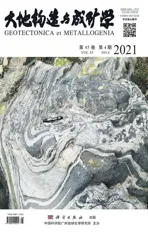西天山伊犁地块早古生代拼贴: 来自碎屑锆石U-Pb年代学和Hf同位素的制约
2021-08-24黄惠明李鹏飞胡万万令佳琪
黄惠明, 李鹏飞, 胡万万, 令佳琪
西天山伊犁地块早古生代拼贴: 来自碎屑锆石U-Pb年代学和Hf同位素的制约
黄惠明1, 2, 3, 李鹏飞1, 2*, 胡万万1, 2, 3, 令佳琪1, 2, 3
(1.中国科学院 广州地球化学研究所, 同位素地球化学国家重点实验室, 广东 广州 510640; 2.中国科学院深地科学卓越创新中心, 广东 广州 510640; 3.中国科学院大学, 北京 100049)
西天山伊犁地块记录着中亚造山带构造演化方面的关键信息, 前人多认为伊犁地块是一个单独块体, 但其西延境外部分对应着多个块体。这些块体在奥陶纪末期完成拼贴, 它们之间的缝合带在西天山的延伸部分被晚古生代‒中新生代地层覆盖, 但通过境内外地质对比, 认为其很可能沿着伊犁地块中部向东延伸, 并将伊犁地块划分为南、北伊犁两个块体。目前, 对于南、北伊犁地块的拼贴时限缺少精确限定, 其是否类似于境外部分于奥陶纪末期完成拼贴仍不清楚。为此, 本项研究选取北伊犁地块志留系库茹尔组为研究对象, 通过开展碎屑锆石U-Pb年代学和Hf同位素分析, 约束南、北伊犁两个块体的拼贴时限。结果显示, 库茹尔组碎屑锆石U-Pb年龄主要集中在早古生代(422~519 Ma), 其最年轻峰值432 Ma约束了库茹尔组的最大沉积时代。在对比南北伊犁地块岩浆活动的基础上, 发现库茹尔组沉积地层同时接收到了南北伊犁地块的物源供给, 表明南北伊犁地块已在库茹尔组沉积前完成拼贴。通过综合解析碎屑锆石及区域岩浆岩锆石Hf同位素数据, 发现其在奥陶纪末期同时向富集和亏损的方向演化, 与显生宙以来东亚多块体拼贴过程中的Hf同位素演化趋势相似, 因而我们将这种Hf()值扇形演化样式归因于南北伊犁地块的碰撞拼贴, 进而约束伊犁地块的拼贴时限在奥陶纪末期。
中亚造山带; 哈萨克斯坦微陆块; 西天山; 伊犁地块; 碎屑锆石
0 引 言
中亚造山带是全球典型的增生型造山带, 其形成演化涉及到一系列微陆块、岩浆弧的碰撞拼贴(Windley et al., 2007; Wilhem et al., 2012; Xiao et al., 2015)。伊犁地块(Yili block)位于中亚造山带西南部的西天山地区, 并向西延伸至境外(图1a)。一些学者认为, 伊犁地块自早古生代起即是一个统一的整体, 并把伊犁地块中具有弧特征的早古生代岩浆岩归因于其南北两侧大洋的俯冲作用(胡霭琴等, 2008; Gao et al., 2009; Qian et al., 2009; Long et al., 2011; Huang et al., 2013; Xu et al., 2013; Gou and Zhang, 2016)。然而也有学者发现, 伊犁地块在境外的延伸部分, 对应多个前寒武纪地块(图1a): 其北部为阿克套‒准噶尔地块(AJ), 南部为科克切塔夫‒北天山地块(KNTB), 二者之间产出另一个楚‒伊犁地块(CY)(Windley et al., 2007; Wang et al., 2012, 2014a, 2014b; Rojas-Agramonte et al., 2014)。目前, 基于古地磁、区域岩浆活动和地层不整合覆盖缝合带等证据, 学术界认为境外这些地块于奥陶纪末期拼贴在一起, 构成哈萨克斯坦微陆块(Kazakhstan microcontinent),并形成了数条早古生代缝合带(Biske and Seltmann, 2010; Alexeiev et al., 2011, 2016; Bazhenov et al., 2012)。这些缝合带向东延伸进入我国西天山伊犁地块内部, 被晚古生代‒中新生代地层覆盖。基于此, Wang et al. (2012, 2014a, 2014b)将伊犁地块划分为南北两个块体(图1b), 但二者拼贴的时间仍不清楚, 其是否如境外延伸部分在奥陶纪末期拼贴仍未限定。
碎屑锆石U-Pb年代学是示踪沉积物源、约束地层时代的有效手段(Bruguier et al., 1997; Cawood and Nemchin, 2000; Cawood et al., 2012), 结合锆石Hf同位素可以有效约束造山带的构造演化过程(Kemp et al., 2009; Gehrels and Pecha, 2014; Han et al., 2016; Huang et al., 2016; Zhang et al., 2016; Li et al., 2020)。本文拟利用该方法, 通过研究北伊犁地块志留系库茹尔组碎屑锆石年龄谱及Hf同位素特征, 以期限定南北伊犁地块的拼贴时限。该地层在北伊犁地块中分布广泛, 出露面积及地层厚度在志留系各组地层中占70%以上(刘晓宇, 2009), 是判别伊犁地块是否在志留纪之前完成拼贴的理想对象。目前, 针对伊犁地块开展的碎屑锆石年代学研究工作, 主要集中在晚古生代地层(Yang et al., 2012; 白建科等, 2015; Huang et al., 2017; 石鑫等, 2018; Wang et al., 2018a, 2018b; 陈有炘等, 2019), 对于早古生代地层, 冯博等(2019)报道了北伊犁地块志留系地层的碎屑锆石年龄谱, 但对其在伊犁地块拼贴中的指示意义未进行深入讨论。
1 地质背景
1.1 哈萨克斯坦微陆块
哈萨克斯坦微陆块位于中亚造山带西南部(图1a), 由数个前寒武纪地块组成, 包括伊希姆‒中天山地块(IMT)、阿克套‒准噶尔地块(AJ)、楚‒伊犁地块(CY)和科克切塔夫‒北天山地块(KNTB)(Windley et al., 2007; Alexeiev et al., 2011)。这些地块沿着数条早古生代缝合带(伊诺曼套‒伊犁缝合带(EY)、扎里尔‒奈曼缝合带(DN)和吉尔吉斯‒帖尔斯克依缝合带(KT)), 于奥陶纪末期拼贴在一起(Bakirov and Maksumova, 2001; Windley et al., 2007; Biske and Seltmann, 2010; Alexeiev et al., 2011, 2015, 2016; Bazhenov et al., 2012; Degtyarev et al., 2013)。
1.2 西天山(伊犁地块及其邻区)
西天山位于天山造山带西段, 夹于准噶尔盆地和塔里木克拉通之间(图1a)。其大地构造格架由北到南可以划分为: 北天山构造带、伊犁地块、中天山地块和南天山构造带(图1b; Gao et al., 1998; Charvet et al., 2011; Xiao et al., 2013)。
北天山构造带呈NWW走向展布, 与南侧的伊犁地块以北天山断层为界(图1b)。其主要包括晚古生代深海相浊积岩及蛇绿混杂岩(Wang et al., 2006; Xiao et al., 2013), 向北呈叠瓦式逆冲推覆到中新生代准噶尔盆地地层之上(Gao et al., 1998; Xiao et al., 2013)。
伊犁地块呈三角形向东尖灭, 是哈萨克斯坦微陆块向东的延伸部分。前寒武基底主要在伊犁地块北缘(温泉地区; 图1b)和南缘(沿北那拉提断层; 图1b)出露, 晚古生代‒中新生代沉积地层覆盖于伊犁地块中部(Gao et al., 1998; Wang et al., 2006)。伊犁地块内分布有大量钙碱性的中酸性岩浆岩, 并主要沿其南北缘出露, 岩浆活动持续时间主要为497~260 Ma (Xu et al., 2013; Han et al., 2016; Huang et al., 2017; Tang et al., 2017; Han and Zhao, 2018)。伊犁地块由南北两个块体拼贴而成(图1b), 南伊犁地块对应阿克套‒准噶尔地块(AJ), 北伊犁地块对应科克切塔夫‒北天山地块(KNTB), 其缝合位置可能在伊犁地块中部, 并被晚古生代至中新生代地层所覆盖(图1b) (Windley et al., 2007; Wang et al., 2012, 2014a, 2014b; Rojas-Agramonte et al., 2014)。
中天山地块呈狭窄细长形向东延伸至巴伦台地区, 与伊犁地块以北那拉提断层为界(Gao et al., 2009; Qian et al., 2009)。中天山地块产出元古代基底, 上覆古生代火山沉积岩, 缺失泥盆系(Xiao et al., 2013; Xia et al., 2014; Cao et al., 2017), 并被奥陶纪‒二叠纪花岗岩侵入(Dong et al., 2011; Gou and Zhang, 2016)。
南天山构造带主要包括志留系‒石炭系海相火山沉积岩, 与蛇绿混杂岩一起被强烈褶皱, 呈叠瓦状向南逆冲推覆到塔里木克拉通北缘之上(Gao et al., 1998, 2009; Xiao et al., 2013), 并被二叠纪火山碎屑岩和中生代陆相碎屑岩覆盖(Han et al., 2016; Huang et al., 2017)。南天山构造带与中天山地块以南那拉提断层为界, 沿着该断层产出有超高压变质岩, 最新的锆石U-Pb和石榴石Lu-Hf年代学研究, 约束其变质峰期年龄为324~312 Ma(Klemd et al., 2011; Li et al., 2011; Su et al., 2011; Yang et al., 2013; Liu et al., 2014)。
2 样品描述和分析方法
2.1 样品描述
沿着北伊犁地块北缘, 早古生代地层出露齐全, 主要包括寒武系磷矿沟组(Є1)、肯萨依组(Є2)、果子沟组(Є3), 奥陶系新二台组(O1)、奈楞格勒达坂组(O2)、呼独克达坂组(O3)和志留系尼勒克河组(S1)、基夫克组(S2)、库茹尔组(S3)、博罗霍洛山组(S3)(蔡土赐等, 1999; 冯博等, 2019)。样品H19WT51采于北伊犁地块志留系库茹尔组(图2), 该组主要为一套浅海相陆源细碎屑岩建造, 可见微波状层理构造(刘晓宇, 2009)。其沉积序列自下而上以海水逐渐变浅为特征, 并在尼勒克河中游剖面的上部层位中产出龟裂构造, 指示该套地层曾暴露于水面之上(张少鹏, 2010)。库茹尔组按岩性分为上下两部分: 下部以灰色‒灰绿色条带状粉砂岩、白云质粉砂岩和钙质粉砂质泥岩为主, 夹凝灰粉砂岩、硅质泥岩及少量砾岩; 上部主要为灰绿色、灰紫色钙质细粒石英砂岩、凝灰质粉砂岩及钙质‒铁质粉砂岩(新疆维吾尔自治区地质矿产局, 1988)。
采样点位于尼勒克县以北20 km处(43°59′13.65″N, 82°37′3.83″E, 图2), 样品野外露头为灰绿色, 岩性为细砂岩, 发育波痕层面构造(图3a)。经显微镜下鉴定, 碎屑以石英为主, 约占60%, 长石、方解石等其他矿物约占15%~20%, 杂基约占20%~25%。碎屑粒度较为均一, 磨圆度较差(图3b)。
2.2 分析方法
沉积岩样品H19WT51应用传统重液和磁选方法分选出锆石, 并用环氧树脂填充固结制成靶, 抛光至显露锆石内部结构。在显微镜下进行锆石透/反射光图像拍摄, 随后在中国科学院广州地球化学研究所(同位素地球化学国家重点实验室)的扫描电镜(JXA-8100, JEOL)下拍摄锆石阴极发光图像(CL), 以此揭示锆石的内部结构。在选取锆石U-Pb年龄和Hf同位素测试点时, 充分避开锆石的裂缝、包裹体等区域。
碎屑锆石U-Pb年龄测试在中国科学院广州地球化学研究所矿物学与成矿学重点实验室, 利用激光剥蚀‒电感耦合‒等离子质谱分析仪(LA-ICP-MS)完成。该仪器配有RESOlution S-155激光剥蚀系统, 激光束斑直径为29 μm, 频率6 Hz。分析过程中使用He作为剥蚀物质载气, 以提高分析的灵敏度。采用91500和Plesovice锆石标样进行同位素分馏校正(Sláma et al., 2008; Liu et al., 2010), 详细分析流程见Liu et al. (2010)。随后使用ICPMSDataCal10.8软件处理数据, 所获得的碎屑锆石U-Pb年龄谐和图和年龄频谱图由ISOPLOT4.15软件绘制而成(Ludwig, 2003)。
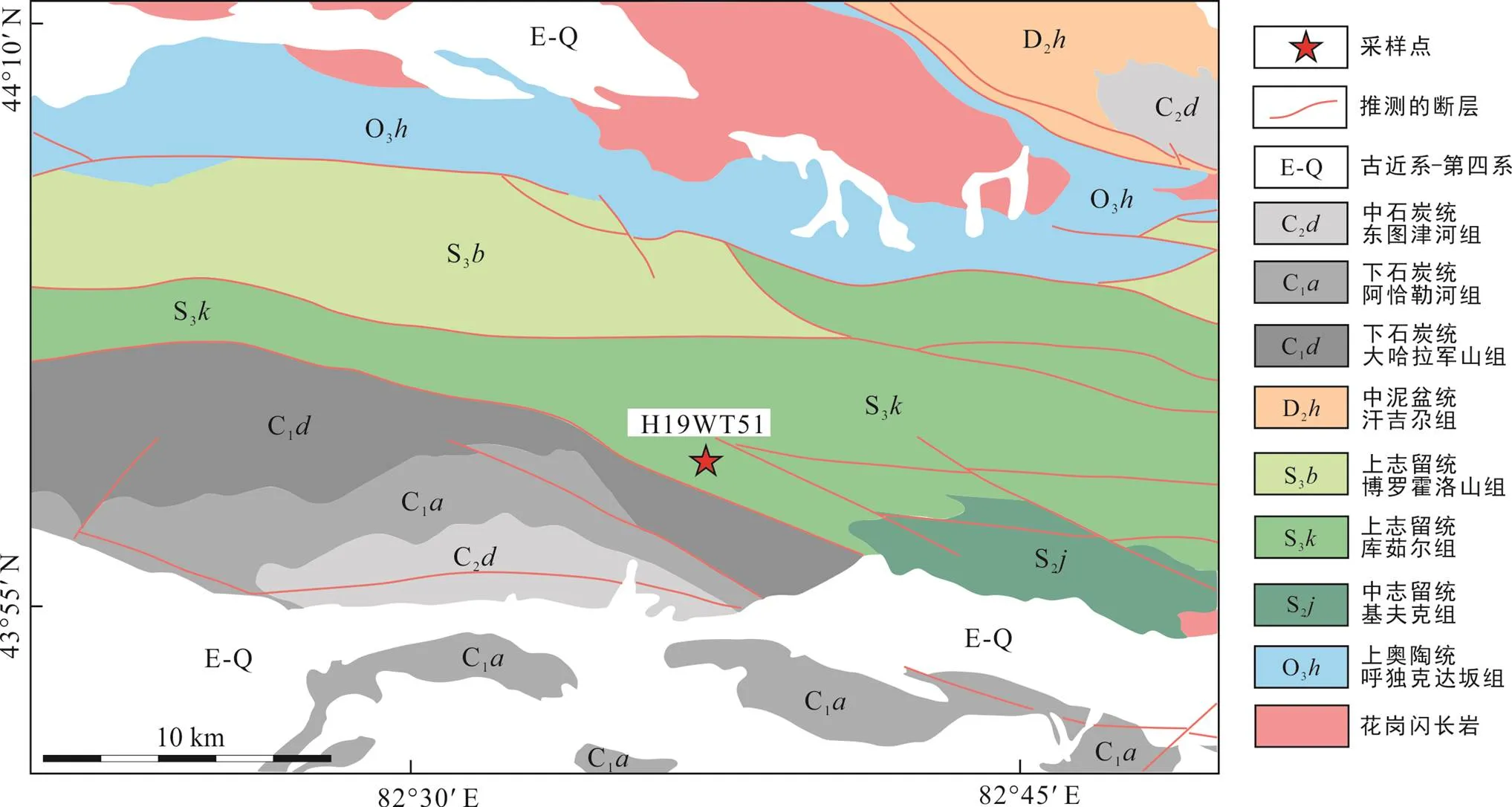
图2 样品采集区地质简图(据新疆维吾尔自治区地质矿产局, 1980, 1988)
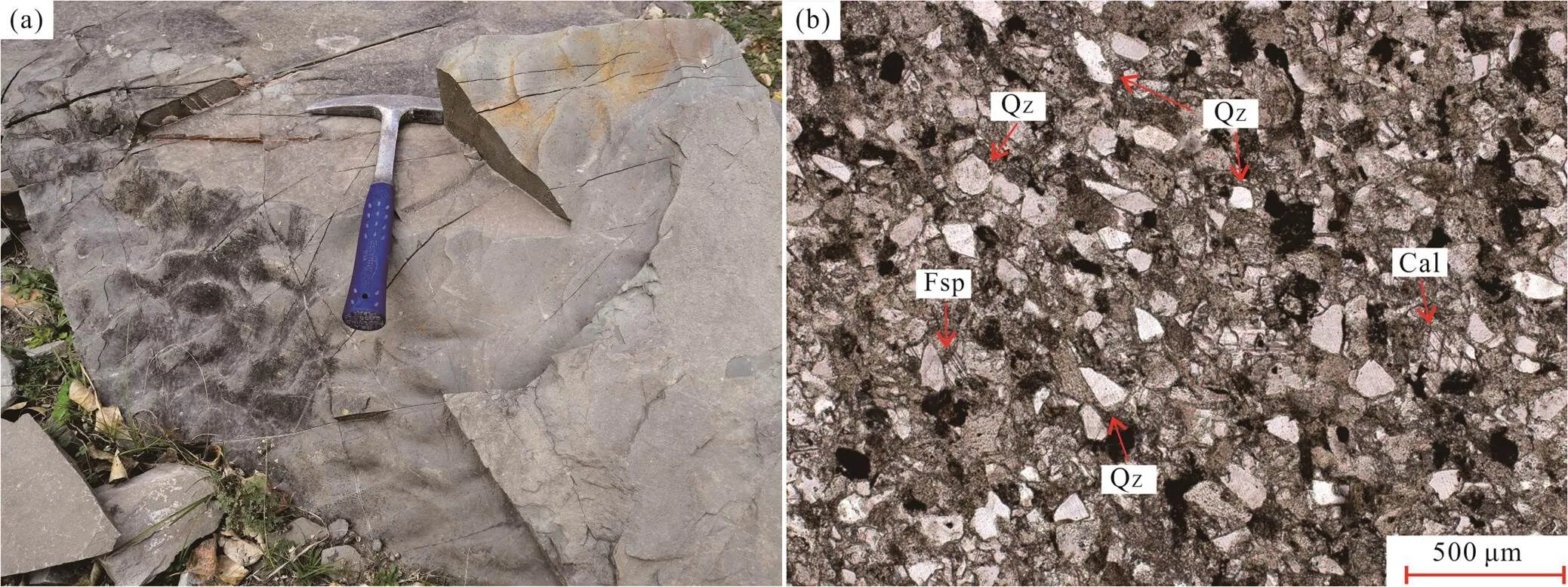
图3 样品H19WT51的野外露头(a, 可见波痕层面构造)和显微镜下特征(b, 碎屑以石英(Qz)、长石(Fsp)、方解石(Cal)为主, 粒度较为均一)
碎屑锆石Hf同位素测试在中国科学院广州地球化学研究所同位素地球化学国家重点实验室, 利用激光剥蚀‒电感耦合‒等离子质谱分析仪(LA-ICP-MS)完成。该仪器配有RESOlution M-50 ArF 193 nm激光剥蚀系统, 激光束斑直径为45 μm, 频率6 Hz。采用Penglai锆石标样与测试样品进行交叉分析校正(Li et al., 2010)。用于校正的176Yb/173Yb和176Lu/175Lu值分别为0.79381 (Segal et al., 2003)和0.02656 (Wu et al., 2006),176Hf/177Hf的质量歧视校正通过179Hf/177Hf=0.7325的指数法则进行。用于计算初始176Hf/177Hf值的176Lu衰变常数选用(1.865 ± 0.015)×10−11a−1(Scherer et al., 2001), 用于计算Hf()值的球粒陨石标准值选用(176Lu/177Hf)CHUR=0.0332±2和(176Hf/177Hf)CHUR, 0=0.282772±29 (Blichert-Toft and Albarède, 1997)。亏损地幔线计算选用当今的176Lu/177Hf=0.0384和176Hf/177Hf=0.28325, 计算锆石二阶段模式年龄(DM2)时选用平均大陆地壳值176Lu/177Hf=0.015 (Griffin et al., 2000)。
3 分析结果
细砂岩样品H19WT51中碎屑锆石U-Pb年龄和Hf同位素分析结果见表1和表2。代表性锆石阴极发光(CL)图像见图4。本次研究中, 大部分锆石具有明显的振荡环带, 颜色偏暗, Th/U值范围为0.15~1.48 (表1), 指示其为典型的岩浆成因锆石(Hanchar and Rudnick, 1995; Hoskin and Schaltegger, 2003)。锆石形态上, 具有一定磨圆(图4), 指示其经历了一定距离的搬运过程。
对样品H19WT51中的65颗锆石开展了U-Pb年代学分析, 对于表观年龄小于1000 Ma的数据, 采用206Pb/238U年龄, 而表观年龄大于1000 Ma的数据, 则选取207Pb/206Pb年龄。63个测试点的年龄误差椭圆落在谐和曲线上(图5a), 可以视为谐和年龄(谐和度大于90%)。其中, 51颗锆石具有早古生代年龄(422~519 Ma), 年龄峰值为432 Ma和447 Ma(图5b), 其余12颗前寒武纪锆石年龄较为分散(903~1755 Ma)。
从上述63颗锆石中选取40颗早古生代年龄的锆石进行Hf同位素分析测试, 获得的Hf()值范围为−7.2~+13.4, 单阶段模式年龄(DM)为0.57~1.33 Ga, 二阶段模式年龄(DM2)为0.61~1.87 Ga(表2, 图6)。
4 讨 论
4.1 库茹尔组的沉积时代
库茹尔组(S3)主要分布在西天山博罗霍洛山南坡, 北伊犁地块内部(图2、7), 上与博罗霍洛山组(S3)呈整合接触, 下与基夫克组(S2)呈不整合接触, 且含少量腕足类和珊瑚类化石(新疆维吾尔自治区地质矿产局, 1988)。李永铁(1993)根据库茹尔组中发现的角石sp.,cf.和三叶虫sp.等化石, 限定库茹尔组的沉积时代为志留纪。
目前, 碎屑锆石年龄被广泛应用于约束地层的沉积时限, 其最年轻年龄可以代表地层的最大沉积时限(Nelson, 2001; Williams, 2001; Fedo et al., 2003)。Dickinson and Gehrels (2009)介绍了3种确定碎屑锆石最年轻年龄的方法, 包括: (1)最年轻单颗粒年龄; (2)年龄频谱图中最年轻峰值年龄; (3)多颗最年轻锆石的年龄加权平均值(误差在1σ或2σ内)。考虑到由Pb丢失引起的最年轻碎屑锆石不具有代表性, 因此本文采用碎屑锆石U-Pb年龄频谱图中最年轻峰值, 约束样品所在地层的最大沉积年龄。这种方法得到的年龄上限可能会略老于真实值(Wang et al., 2018b), 但却是最保守可靠的。样品H19WT51碎屑锆石U-Pb年龄频谱图(图5b), 显示出最年轻峰值为432 Ma, 因而约束库茹尔组的最大沉积年龄为志留纪中期。冯博等(2019)也对库茹尔组砂岩开展了碎屑锆石U-Pb年代学研究, 获得最年轻的锆石年龄为425 Ma, 与本研究得出的432 Ma较为接近(图8c、d)。
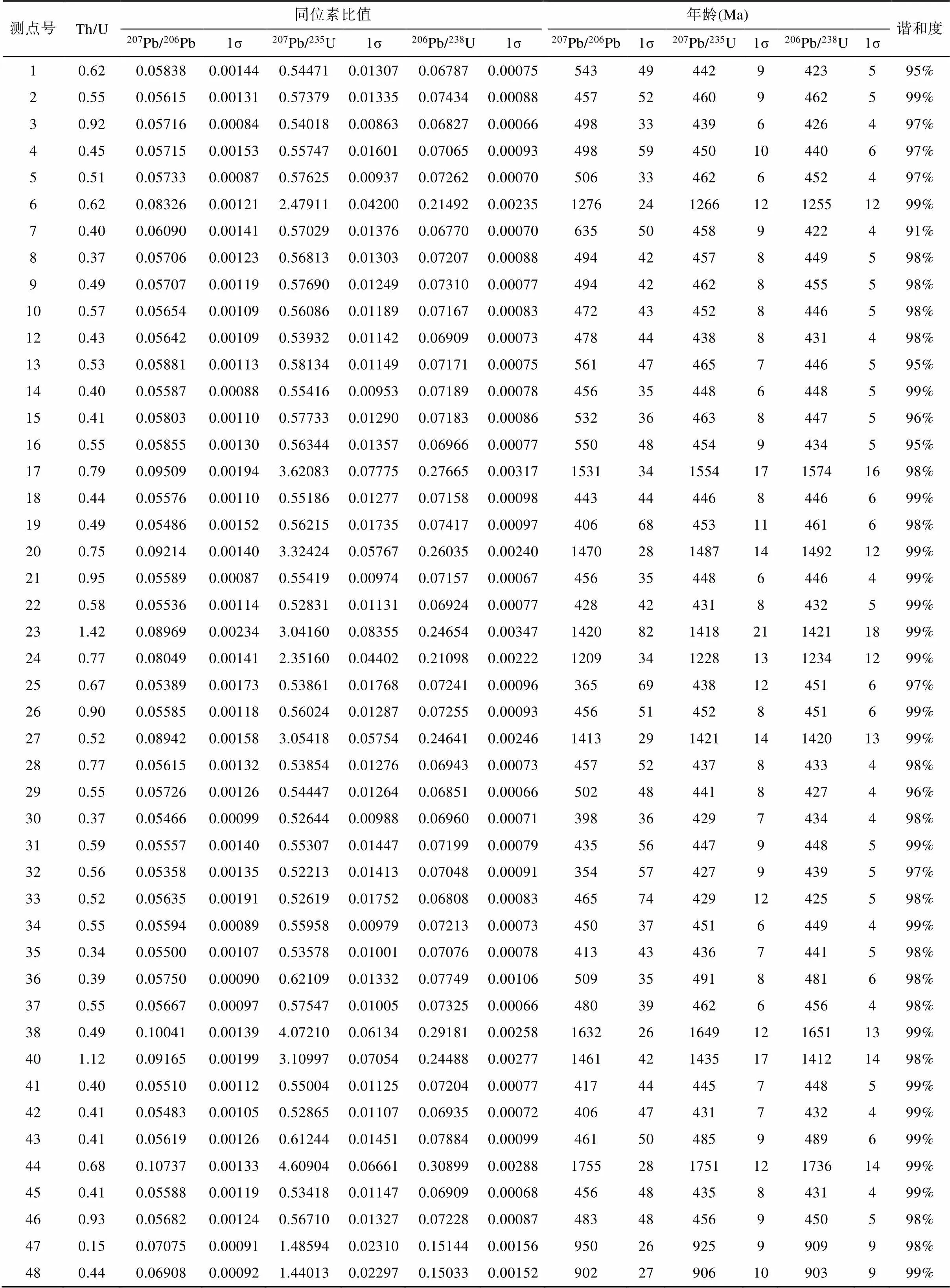
表1 样品H19WT51碎屑锆石U-Pb年龄数据
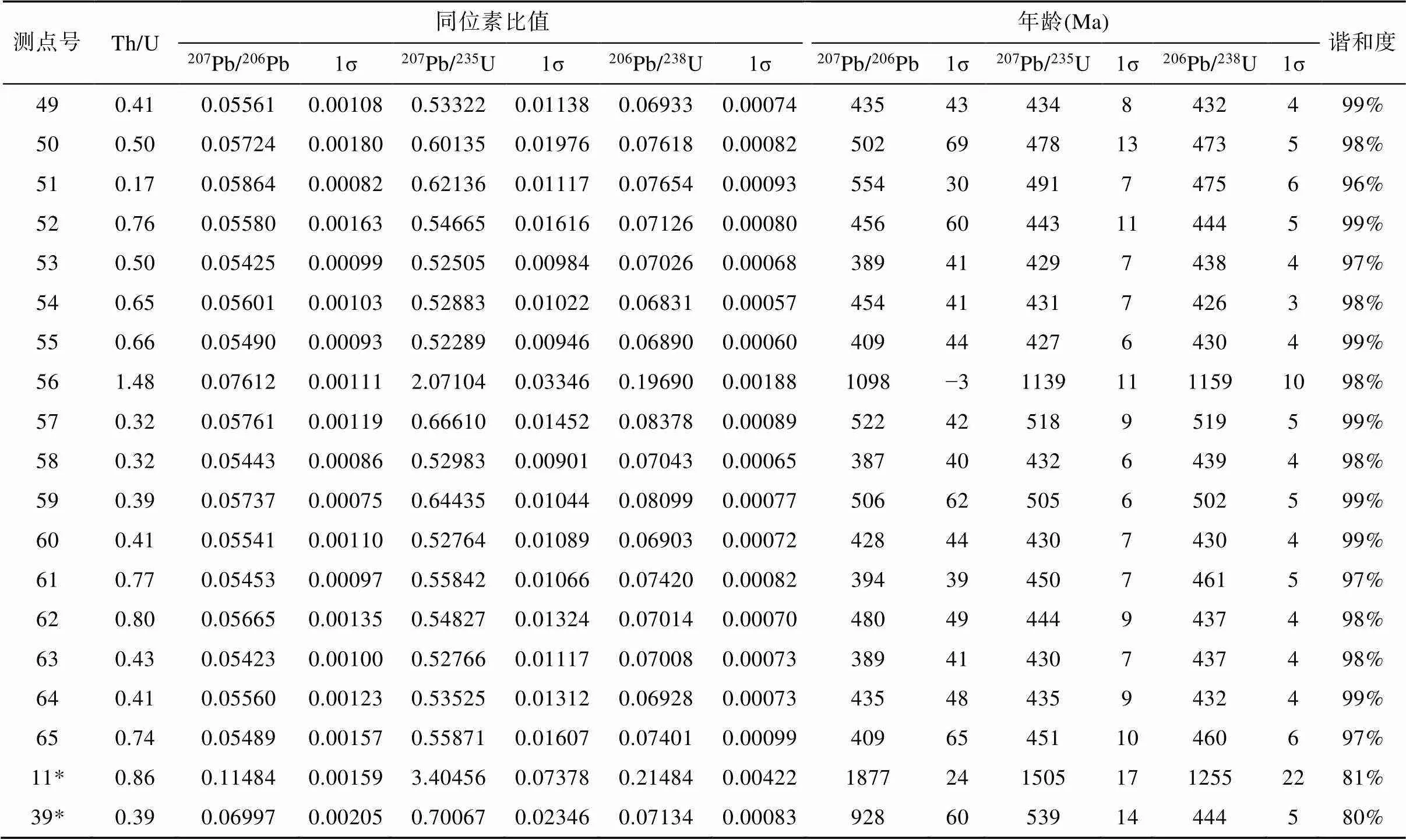
续表1:
注: 标注*的测点是未用于统计的不谐和年龄数据。

表2 样品H19WT51碎屑锆石Lu-Hf同位素测试结果
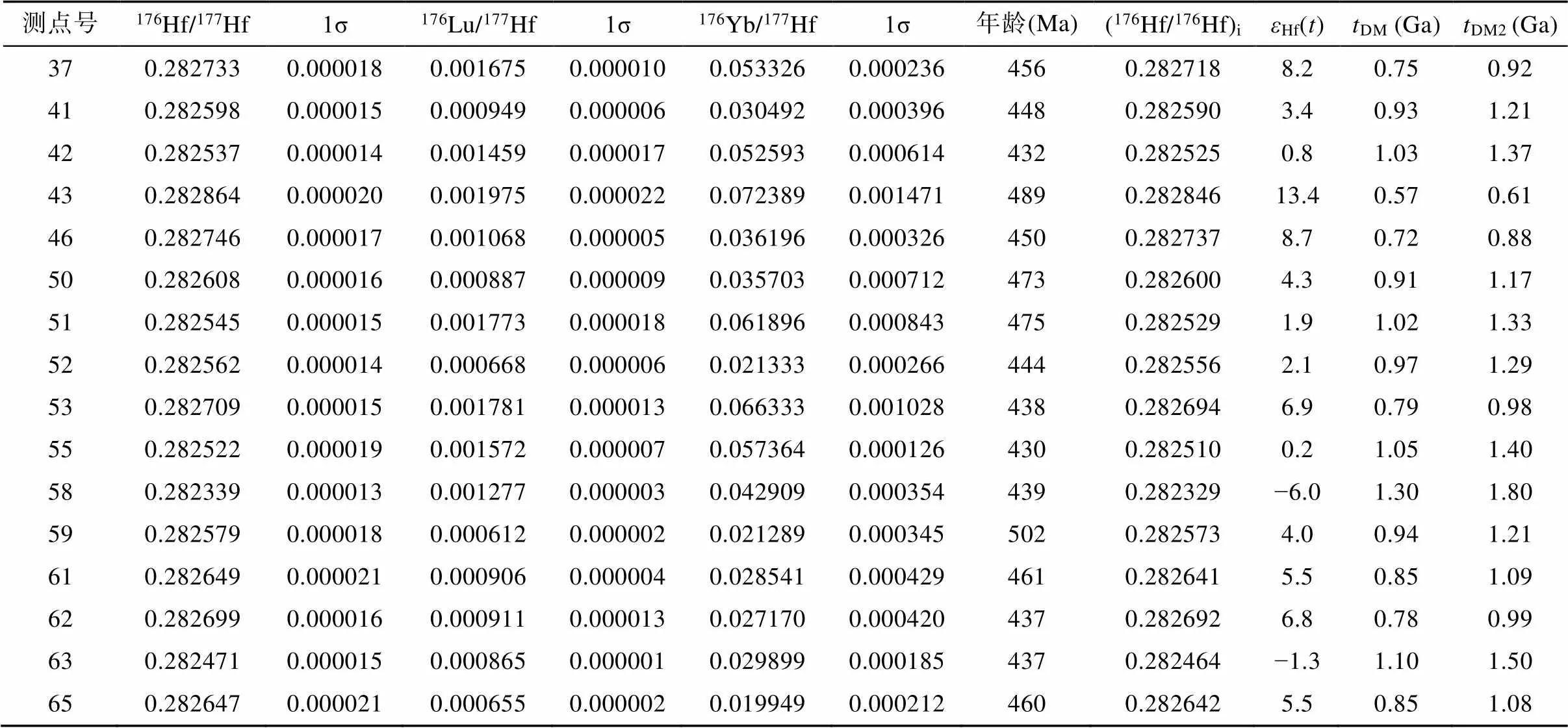
续表2:
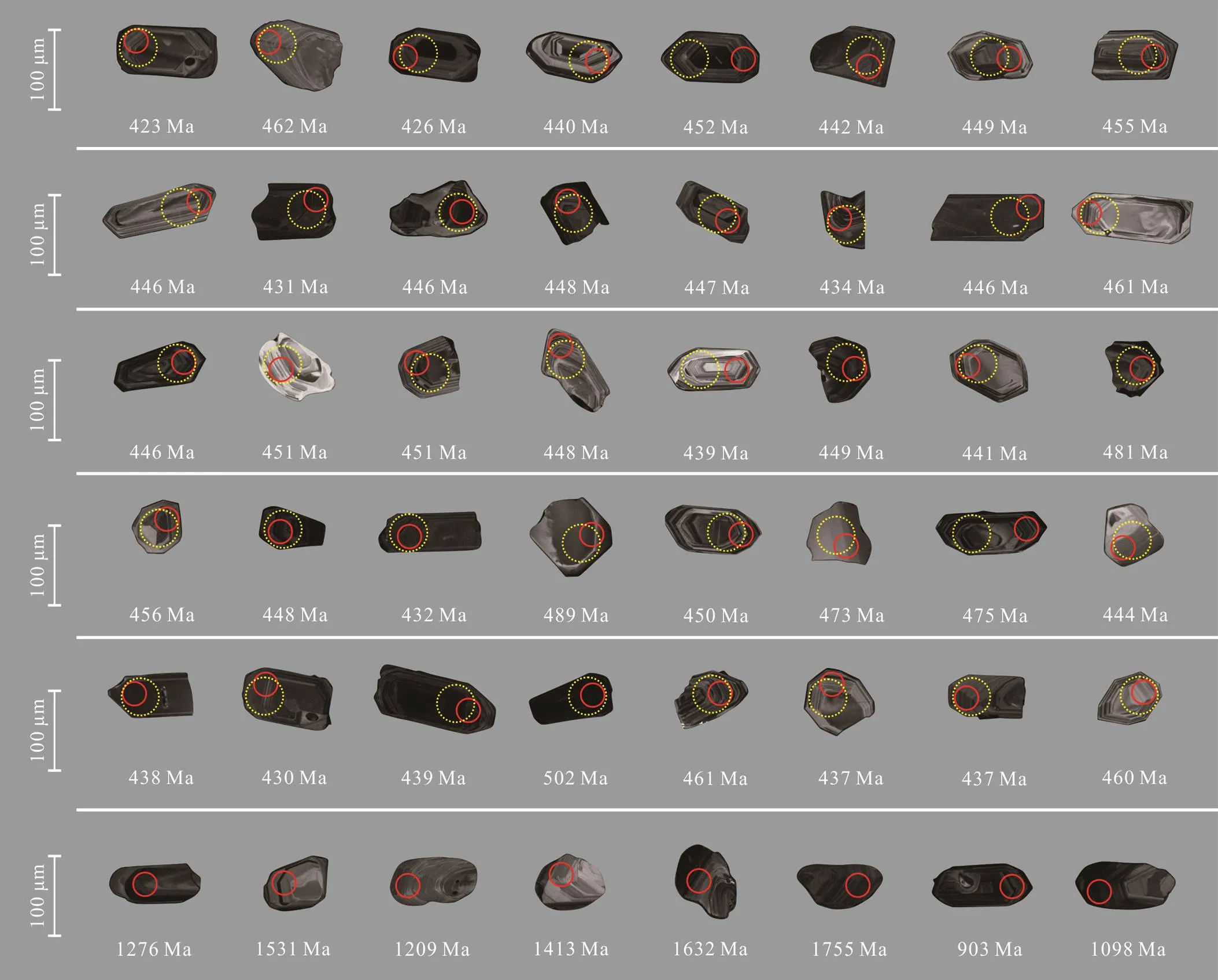
图4 样品H19WT51代表性碎屑锆石阴极发光(CL)图(实线圈为U-Pb测试位置, 直径为29 μm; 虚线圈为Hf测试位置, 直径为45 μm)
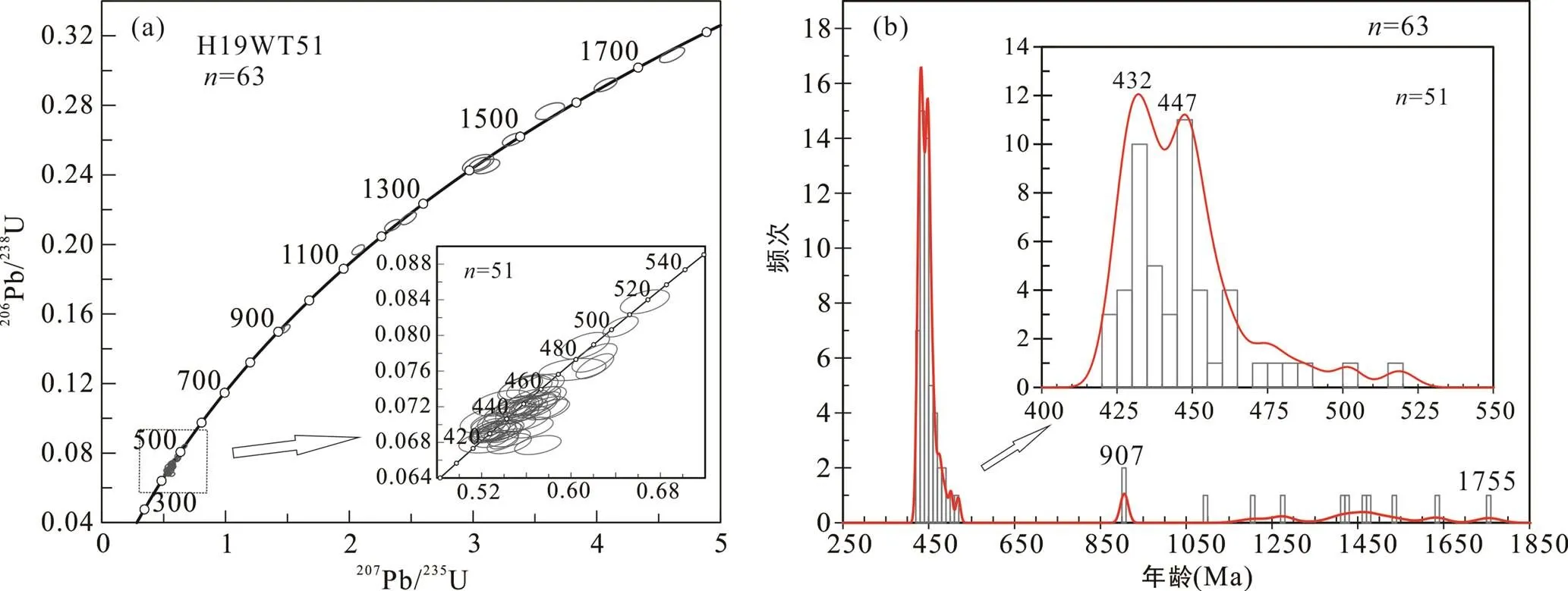
图5 样品H19WT51碎屑锆石U-Pb年龄谐和图(a)和年龄频谱图(b)
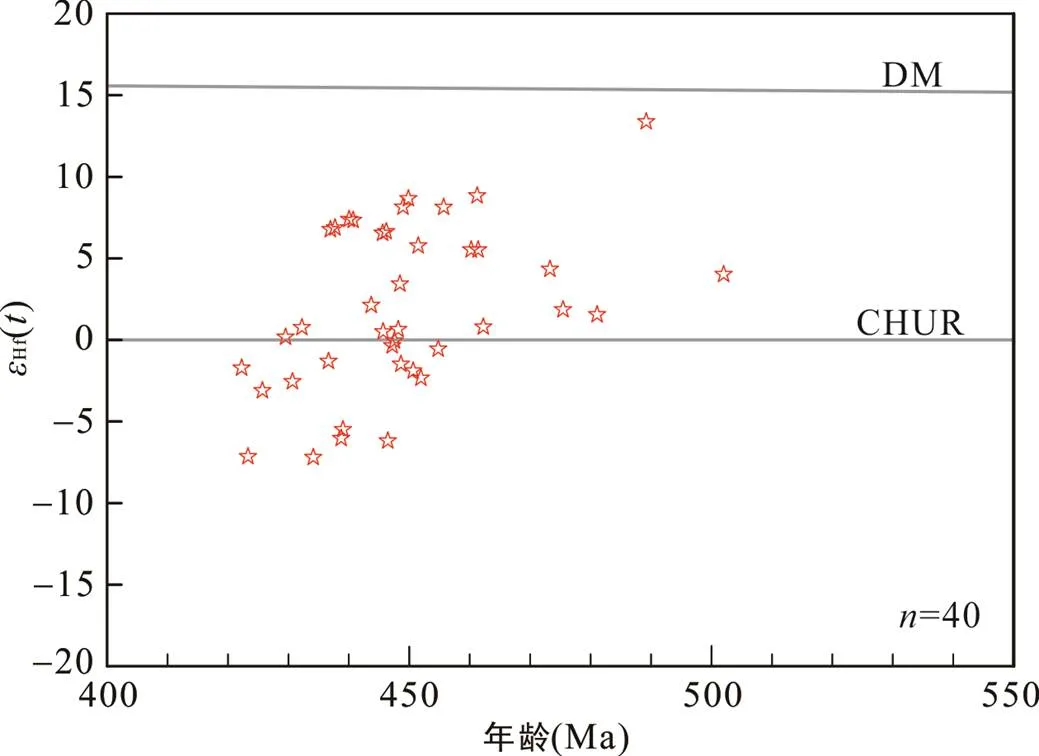
图6 样品H19WT51碎屑锆石Hf同位素特征图
综上所述, 碎屑锆石年龄数据支持前人通过古生物化石限定库茹尔组为志留系沉积地层的结论。
4.2 沉积物源分析
本次研究在库茹尔组砂岩样品(H19WT51)中获得51颗碎屑锆石年龄集中在早古生代(422~519 Ma), 其余12颗前寒武纪的锆石年龄较为分散(903~1755 Ma) (图5b)。目前, 在北伊犁地块报道有前寒武纪岩浆岩产出, 年龄主要集中在777~1069 Ma(陈义兵等, 1999;李继磊等, 2009; 胡霭琴等, 2010; Wang et al., 2014a, 2014b), 其可能是库茹尔组新元古代碎屑锆石的主要来源。而北伊犁地块温泉地区(图1b)新元古代变质沉积岩广泛产出中元古代碎屑锆石(Huang et al., 2016), 其年龄与库茹尔组中的中元古代碎屑锆石年龄相似, 因而其可能是后者中元古代碎屑锆石的主要来源。此外, 通过系统收集整理前人关于伊犁地块早古生代岩浆岩年龄数据(图7, 表3), 发现北伊犁地块温泉地区产出的早古生代岩浆岩, 年龄主要集中在447~466 Ma(胡霭琴等, 2008; Wang et al., 2012; Huang et al., 2013); 而在南伊犁地块, 早古生代岩浆岩空间上沿北那拉提断层带展布, 年龄跨度为426~516 Ma(韩宝福等, 2004; 朱志新等, 2006; Gao et al., 2009; Qian et al., 2009; 徐学义等, 2010; Long et al., 2011; 朱永峰, 2012; Xu et al., 2013; Gou and Zhang, 2016)。地球化学研究显示部分早古生代岩浆岩富集Rb、Sr、Ba、K等大离子亲石元素, 亏损Nb、Ta、Ti等高场强元素, 指示其可能产出于俯冲环境(Gao et al., 2009; Qian et al., 2009; Wang et al., 2012; Huang et al., 2013; Xu et al., 2013; Gou and Zhang, 2016)。北伊犁地块和南伊犁地块的早古生代岩浆岩, 与库茹尔组砂岩样品H19WT51中的早古生代碎屑锆石年龄一致(图8a~d), 因而可能是早古生代碎屑锆石的主要来源。
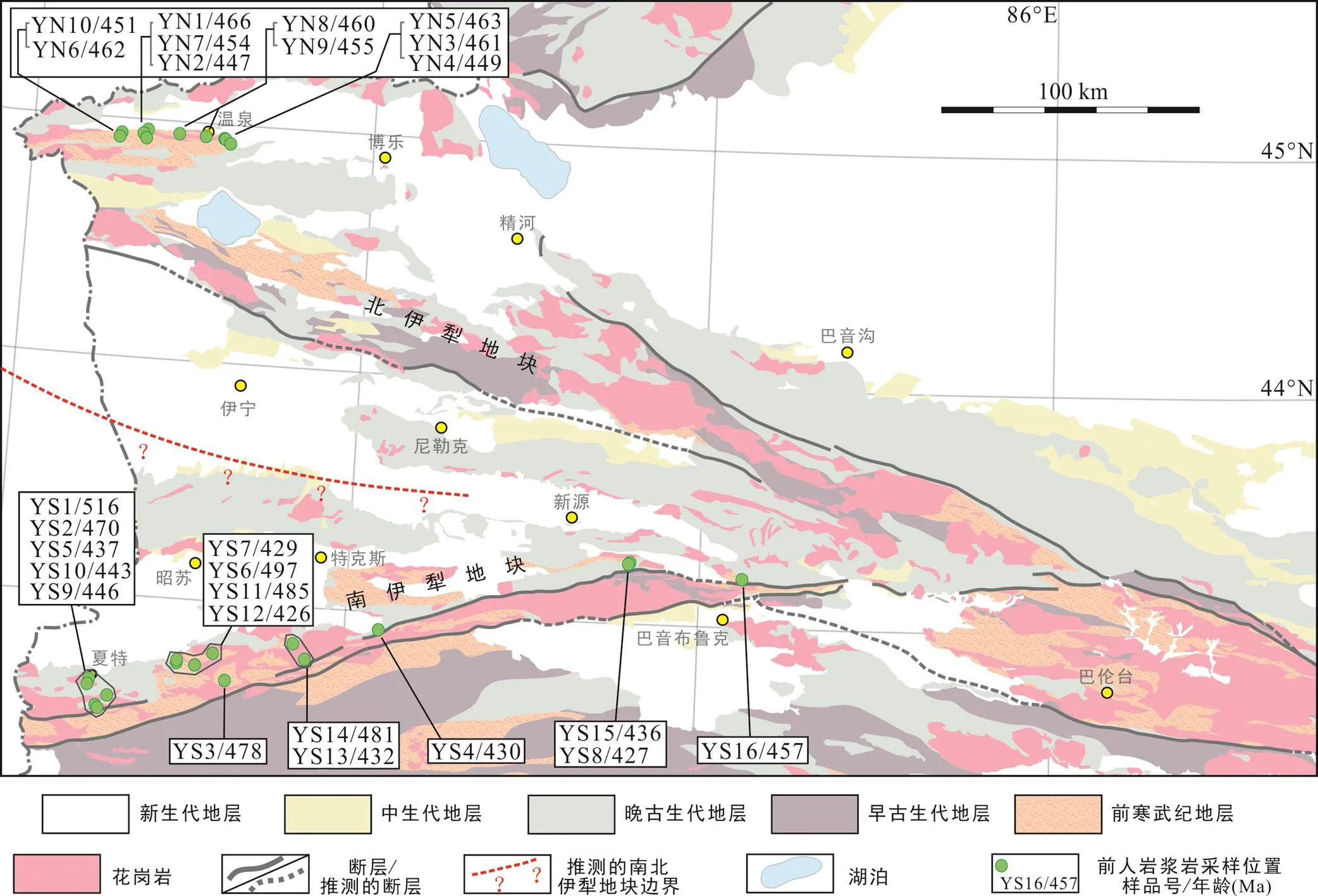
图7 西天山伊犁地块早古生代岩浆岩分布图(据王洪亮等, 2007; 岩浆岩年龄的参考文献信息见表3)
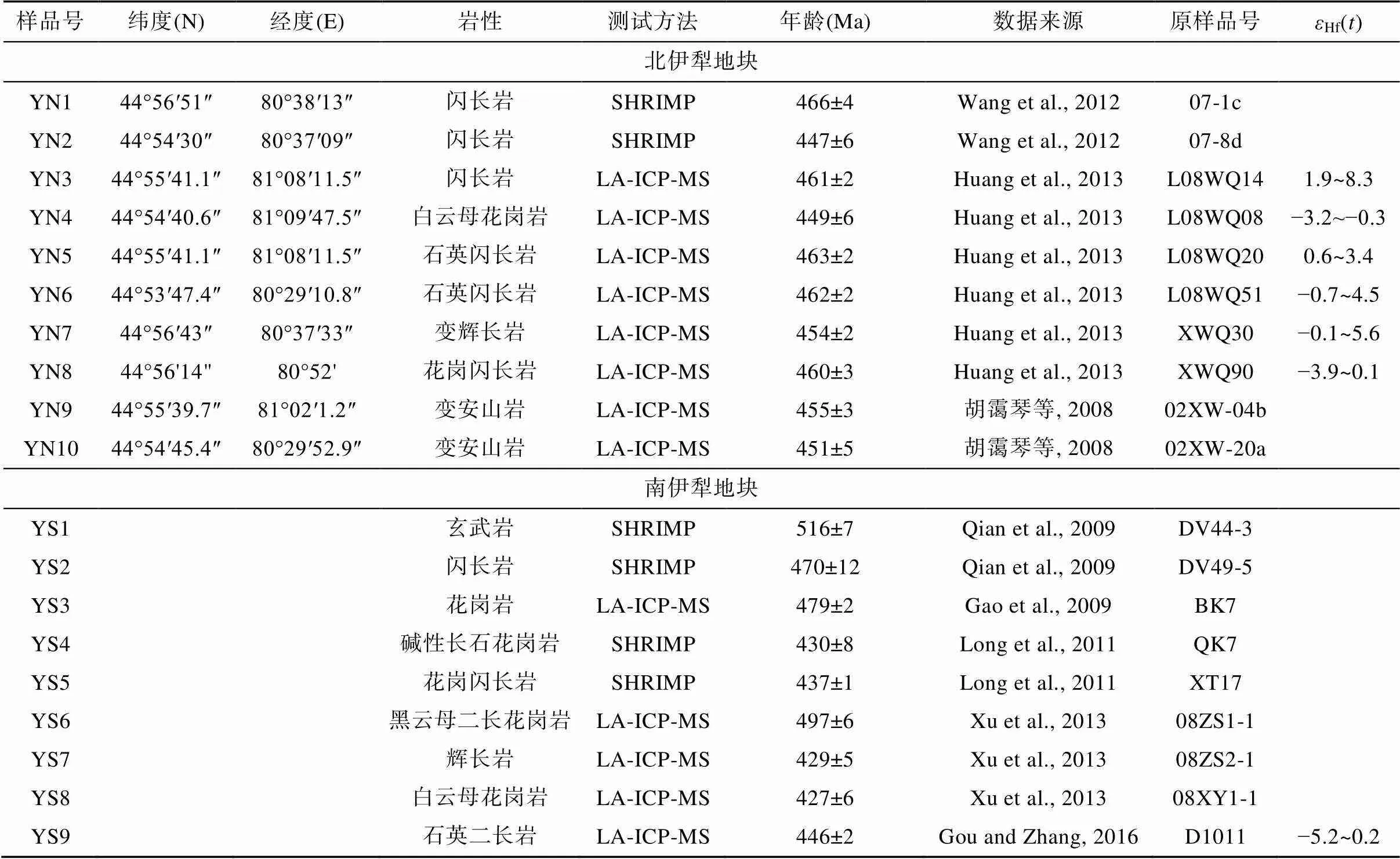
表3 西天山伊犁地块早古生代岩浆岩锆石年龄数据

续表3:
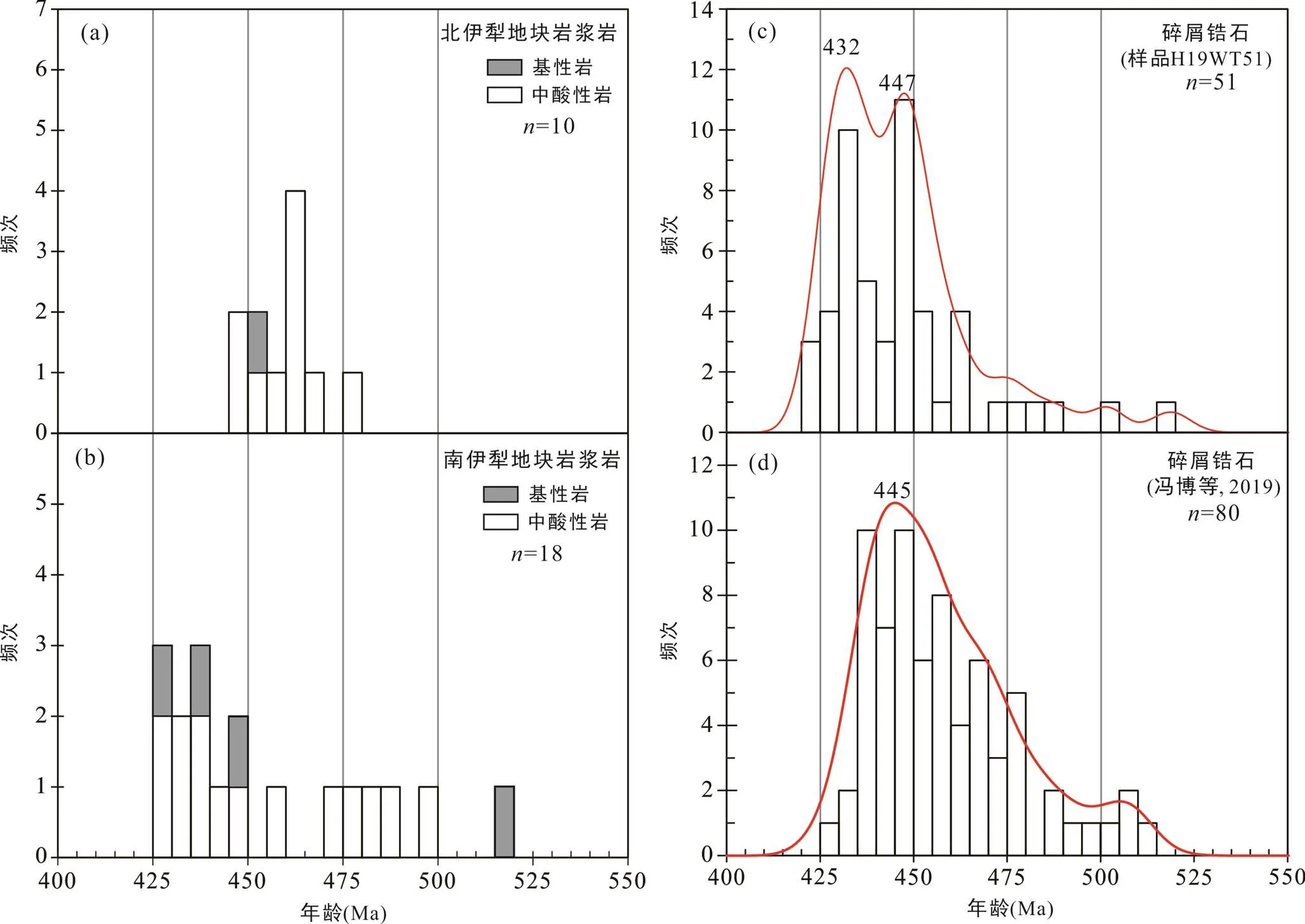
岩浆岩年龄数据来源见表3。
4.3 伊犁地块早古生代构造演化
如前文所述, 伊犁地块西延境外部分对应多个前寒武纪块体, 其缝合带很可能沿着伊犁地块中部向东延伸, 将伊犁地块分为南、北伊犁两个块体(图1a、b)(Windley et al., 2007; Wang et al., 2012, 2014a, 2014b; Rojas-Agramonte et al., 2014)。其中, 北伊犁地块早古生代岩浆岩主要集中在447~466 Ma(图8a), 相比于库茹尔组中423~519 Ma的碎屑锆石, 缺少423~447 Ma和466~519 Ma的年龄, 显示北伊犁地块不能为其内部的库茹尔组提供全部物源。而南伊犁地块产出小于447 Ma和大于466 Ma的早古生代岩浆岩(图8b), 可为北伊犁地块中库茹尔组提供该时期物源。由此可见, 南北伊犁地块均为库茹尔组提供了早古生代物源, 这指示南北伊犁地块于志留系库茹尔组沉积前已完成拼贴。
碎屑锆石Hf同位素在奥陶纪末期(约450 Ma)逐渐变得相对富集(图9c), 指示源区地壳混染程度加大, 可能与地壳加厚有关。但本次研究仅有40个锆石Hf同位素数据, 为弥补数据量不足的问题, 综合了西天山伊犁地块早古生代岩浆岩的Hf同位素数据(图9a、b), 并把岩浆岩中的锆石和样品H19WT51的碎屑锆石Hf同位素特征进行综合投图(图9d), 系统约束伊犁地块早古生代岩浆Hf同位素演化趋势。结果显示, 锆石Hf()值在奥陶纪末期呈扇形演化样式, 其岩浆源区向富集和亏损方向的演化程度明显增强(图9d灰色箭头)。Collins et al. (2011)通过统计全球显生宙造山带中的锆石Hf同位素数据, 发现在环太平洋增生造山体系中, 随着俯冲的持续进行,年轻洋壳物质不断底垫到上覆板片之下, 导致岩浆岩锆石的Hf()值向着正值方向演化, 指示其源区趋向于亏损。而在显生宙亚洲多块体碰撞造山过程中, 随着微陆块拼贴底垫、岩石圈拆沉、造山带垮塌及俯冲翻转等动力学过程,Hf()值同时向着正和负值方向演化, 并在中新生代Hf()值范围达到了−33~+20(图9e), 这种Hf()扇形演化样式指示其源区同时趋向于富集和亏损,与伊犁地块早古生代Hf同位素演化样式类似。由图9所见, 大约在450 Ma之后, 伊犁地块中Hf()值演化到了更宽的范围(−9~+14, 图9d), 指示南北伊犁地块可能在奥陶纪末期碰撞拼贴, 从而导致了Hf()的扇形演化样式。
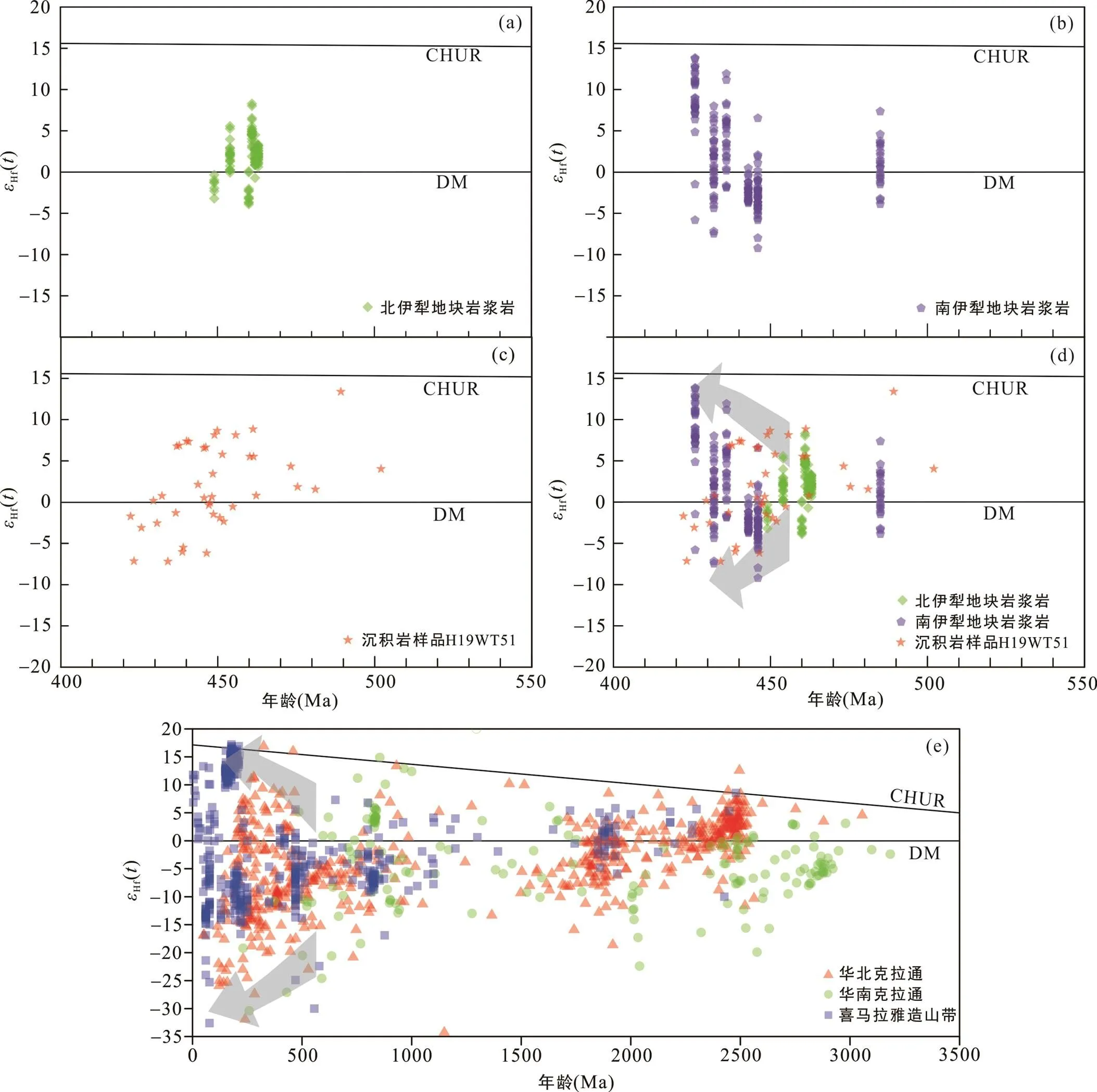
岩浆岩中锆石Hf同位素数据来源见表3。
伊犁地块的境外延伸部分大致于奥陶纪末期拼贴形成哈萨克斯坦微陆块, 主要证据包括: (1)中‒上奥陶统沉积地层不整合覆盖在这些块体之间的缝合带之上(Degtyarev, 2003; Alexeiev et al., 2011, 2016); (2)侵入吉尔吉斯‒帖尔斯克依缝合带(KT)的钉合岩体锆石U-Pb年龄约为460 Ma (Degtyarev et al., 2013); (3)区域内的花岗质岩浆活动在450~435 Ma达到峰期, 可能与哈萨克斯坦微陆块的形成有关(Alexeiev et al., 2016); (4)古地磁及古生物数据指示这些地块在奥陶纪末期‒志留纪早期具有相似的古纬度(Bazhenov et al., 2012)。本研究得出的伊犁地块拼贴时间(奥陶纪末期), 与境外对应块体的拼贴时间大致吻合, 因此伊犁地块的拼合可能对应着中亚西部哈萨克斯坦微陆块的形成。
综合本研究获得的碎屑锆石数据和区域地质资料, 我们推测在早中奥陶世, 南北伊犁地块之间可能存在着一个古洋盆(图10a), 并在奥陶纪末期, 洋盆闭合, 南北伊犁地块发生碰撞拼贴, 构成统一的伊犁地块(图10b)。随后在早中泥盆世, 受到准噶尔洋的俯冲作用, 在哈萨克斯坦微陆块之上形成了泥盆纪岩浆岩带(DVB, 图1a、10c)(Wang et al., 2006; Windley et al., 2007; Xiao et al., 2013)。前人把北伊犁地块中具有弧特征的早古生代岩浆岩归因于伊犁地块北侧洋盆的南向俯冲(胡霭琴等, 2008; Wang et al., 2012; Huang et al., 2013), 把南伊犁地块中具有弧特征的早古生代岩浆岩归因于伊犁地块南侧洋盆的北向俯冲(朱志新等, 2006; Gao et al., 2009; Qian et al., 2009; 徐学义等, 2010; Long et al., 2011; 朱永峰, 2012; Xu et al., 2013; Gou and Zhang, 2016)。这些解释均基于伊犁地块为一个仅受到南北两侧大洋俯冲作用影响的单独块体, 但伊犁地块可能由两个块体拼贴而成, 二者之间洋盆的俯冲消亡, 很可能导致了早古生代弧岩浆岩的产出(图10a)。
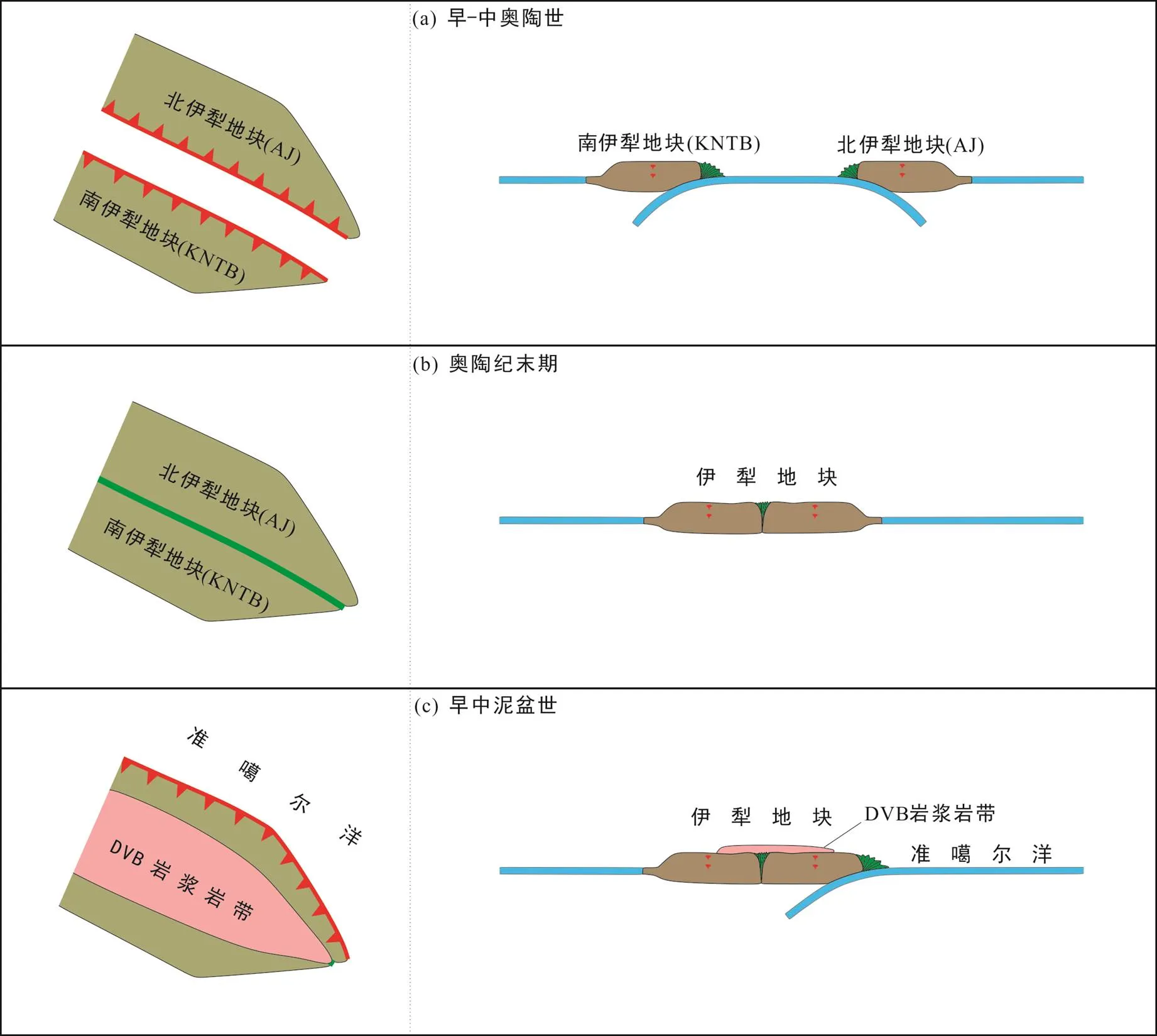
(a) 早中奥陶世, 南北伊犁地块之间存在一个古洋盆, 其俯冲形成早古生代岩浆岩; (b) 奥陶纪末期, 洋盆闭合, 南北伊犁地块发生碰撞拼贴; (c)早中泥盆世, 伊犁地块北侧的准噶尔洋南向俯冲于伊犁地块之下, 形成泥盆纪岩浆岩带(DVB: Devonian Volcanic Belt; 见图1a)。注: 北伊犁地块可能对应于阿克套‒准噶尔地块(AJ), 南伊犁地块可能对应于科克切塔夫‒北天山地块(KNTB)。
5 结 论
(1) 北伊犁地块中库茹尔组碎屑锆石U-Pb年龄主要集中在早古生代(422~519 Ma), 其Hf()值为−7.2~+13.4, 少量分散的前寒武纪年龄在903~1755 Ma之间。综合碎屑锆石最年轻峰值432 Ma及前人的古生物化石资料, 约束库茹尔组的沉积时代为志留纪。
(2) 伊犁地块可能由南北伊犁两个块体拼贴而成, 通过对比南北伊犁地块岩浆活动和碎屑锆石年龄产出特征, 发现北伊犁地块库茹尔组同时接收了南北伊犁地块的物源供给, 显示其在伊犁地块拼贴后沉积。综合分析碎屑锆石和区域岩浆岩中锆石的Hf同位素特征, 发现锆石Hf()值在奥陶纪末期呈扇形演化, 其源区同时趋向于亏损和富集, 指示南北伊犁地块可能在这一时期发生碰撞拼贴, 形成统一的伊犁地块。
致谢:实验测试过程中得到了中国科学院广州地球化学研究所吴丹工程师和张乐工程师的技术指导, 2名匿名审稿人提出了宝贵的修改意见, 在此深表谢意!
白建科, 李智佩, 徐学义, 李婷, 茹艳娇, 李晓英. 2015. 西天山乌孙山地区大哈拉军山组碎屑锆石U-Pb定年及其地质意义. 中国地质, 42(1): 85–96.
蔡土赐, 孙巧缡, 缪长泉. 1999. 新疆维吾尔自治区岩石地层. 武汉: 中国地质大学出版社: 1–430.
陈义兵, 胡霭琴, 张国新, 张前锋. 1999. 西天山前寒武纪天窗花岗片麻岩的锆石U-Pb年龄及Nd-Sr同位素特征. 地球化学, 28(6): 515–520.
陈有炘, 裴先治, 赵军, 王盟, 关力伟, 朱永胜, 刘雷, 杜古尔·卫卫, 田增彪. 2019. 西天山温泉地区下石炭统阿克沙克组碎屑锆石U-Pb年龄及其构造意义. 地球科学, 44(7): 2478–2492.
冯博, 计文化, 白建科, 刘一珉, 陈喜庆. 2019. 西天山博罗科努地区志留系碎屑锆石U-Pb定年及其地质意义. 地质通报, 38(Z1): 276–287.
韩宝福, 何国琦, 吴泰然, 李惠民. 2004. 天山早古生代花岗岩锆石U-Pb定年、岩石地球化学特征及其大地构造意义. 新疆地质, 22(1): 4–11.
胡霭琴, 韦刚健, 江博明, 张积斌, 邓文峰, 陈林丽. 2010. 天山0.9 Ga新元古代花岗岩SHRIMP锆石U-Pb年龄及其构造意义. 地球化学, 39(3): 197–212.
胡霭琴, 韦刚健, 张积斌, 邓文峰, 陈林丽. 2008. 西天山温泉地区早古生代斜长角闪岩的锆石SHRIMP U–Pb年龄及其地质意义. 岩石学报, 24(12): 2731–2740.
李继磊, 苏文, 张喜, 刘新. 2009. 西天山阿吾拉勒西段麻粒岩相片麻岩锆石Cameca U-Pb年龄及其地质意义. 地质通报, 28(12): 1852–1862.
李永铁. 1993. 新疆博罗科努地区志留系库茹尔组头足类等化石的发现及其时代讨论. 新疆地质, 11(3): 204– 206.
刘晓宇. 2009. 新疆尼勒克胡吉尔台一带志留系研究. 西安: 长安大学硕士学位论文: 1–71.
石鑫, 侯明才, 黄虎, 胡小龙, 江文剑, 吴斌, 缪宗利, 郑斯赫. 2018. 伊犁盆地南缘中‒下侏罗统物源分析及其对南天山造山带演化的启示. 沉积学报, 36(3): 446–455.
王洪亮, 徐学义, 何世平, 陈隽璐. 2007. 中国天山及邻区地质图 (1∶100万). 地质出版社.
新疆维吾尔自治区地质矿产局. 1980. 新疆巩留幅1∶20万地质图及说明书.
新疆维吾尔自治区地质矿产局. 1988. 新疆精河幅1∶20万地质图及说明书.
徐学义, 王洪亮, 马国林, 李平, 陈隽璐, 李婷. 2010. 西天山那拉提地区古生代花岗岩的年代学和锆石Hf同位素研究. 岩石矿物学杂志, 29(6): 691–706.
张少鹏. 2010. 伊犁西天山早古生代构造演化和岩相古地理研究. 西安: 西北大学硕士学位论文: 1–83.
朱永峰. 2012. 西南天山科桑溶洞新元古代‒早奥陶世花岗岩锆石U-Pb年代学研究. 岩石学报, 28(7): 2113– 2120.
朱志新, 王克卓, 郑玉洁, 孙桂华, 张超, 李亚萍. 2006. 新疆伊犁地块南缘志留纪和泥盆纪花岗质侵入体锆石SHRIMP定年及其形成时构造背景的初步探讨. 岩石学报, 22(5): 1193–1200.
Alexeiev D V, Biske Y S, Wang B, Djenchuraeva A V, Getman O F, Aristov V A, Kröner A, Liu H S and Zhong L L. 2015. Tectono-Stratigraphic framework and Palaeozoic evolution of the Chinese South Tianshan., 49(2): 93–122.
Alexeiev D V, Kröner A, Hegner E, Rojas-Agramonte Y, Biske Y S, Wong J, Geng H Y, Ivleva E A, Mühlberg M, Mikolaichuk A V and Liu D. 2016. Middle to Late Ordovician arc system in the Kyrgyz Middle Tianshan: From arc-continent collision to subsequent evolution of a Palaeozoic continental margin., 39: 261–291.
Alexeiev D V, Ryazantsev A V, Kröner A, Tretyakov A A, Xia X and Liu D Y. 2011. Geochemical data and zircon ages for rocks in a high-pressure belt of Chu-Yili Mountains, southern Kazakhstan: Implications for the earliest stages of accretion in Kazakhstan and the Tianshan., 42(5): 805– 820.
Bakirov A B and Maksumova R A. 2001. Geodynamic evolution of the Tien Shan lithosphere., 42(10): 1435–1443.
Bazhenov M L, Levashova N M, Degtyarev K E, Van der Voo R, Abrajevitch A V and McCausland P J A. 2012. Unraveling the early-middle Paleozoic paleogeography of Kazakhstan on the basis of Ordovician and Devonian paleomagnetic results., 22(3–4): 974–991.
Biske Y S and Seltmann R. 2010. Paleozoic Tian-Shan as a transitional region between the Rheic and Urals-Turkestan oceans., 17(2−3): 602–613.
Blichert-Toft J and Albarède F. 1997. The Lu-Hf isotope geochemistry of chondrites and the evolution of the mantle-crust system., 148(1): 243–258.
Bruguier O, Lancelot J R and Malavieille J. 1997. U-Pb dating on single detrital zircon grains from the Triassic Songpan-Ganze flysch (Central China): Provenance and tectonic correlations., 152(1): 217–231.
Cao Y C, Wang B, Jahn B M, Cluzel D, Shu L S and Zhong L L. 2017. Late Paleozoic arc magmatism in the southern Yili Block (NW China): Insights to the geodynamic evolution of the Balkhash-Yili continental margin, Central Asian Orogenic Belt., 278: 111–125.
Cawood P A and Nemchin A A. 2000. Provenance record of a rift basin: U/Pb ages of detrital zircons from the Perth Basin, Western Australia., 134(3): 209–234.
Cawood P A, Hawkesworth C J and Dhuime B. 2012. Detrital zircon record and tectonic setting., 40(10): 875–878.
Charvet J, Shu L S, Laurent-Charvet S, Wang B, Faure M, Cluzel D, Yan C and De Jong K. 2011. Palaeozoic tectonic evolution of the Tianshan belt, NW China.:, 54(2): 166–184.
Collins W J, Belousova E A, Kemp A I S and Murphy J B. 2011. Two contrasting Phanerozoic orogenic systems revealed by hafnium isotope data., 4(5): 333–337.
Degtyarev K E, Ryazantsev A V, Tretyakov A A, Tolmacheva T Y, Yakubchuk A S, Kotov A B, Salnikova E B and Kovach V P. 2013. Neoproterozoic-Early Paleozoic tectonic evolution of the western part of the Kyrgyz Ridge (Northern Tian Shan) caledonides., 47: 377–417.
Degtyarev K E. 2003. Position of the Aktau-Dzhungar microcontinent in the structural framework of the Paleozoides of Central Kazakhstan., 37(4): 271–288.
Dickinson W R and Gehrels G E. 2009. Use of U-Pb ages of detrital zircons to infer maximum depositional ages of strata: A test against a Colorado Plateau Mesozoic database., 288(1–2): 115–125.
Dong Y P, Zhang G W, Neubauer F, Liu X M, Hauzenberger C, Zhou D W and Li W. 2011. Syn- and post- collisionalgranitoids in the Central Tianshan orogen: Geochemistry, geochronology and implications for tectonic evolution., 20(2–3): 568–581.
Fedo C M, Sircombe K N and Rainbird R H. 2003. Detrital zircon analysis of the sedimentary record., 53(1): 277–303.
Gao J, Li M S, Xiao X C, Tang Y Q and He G Q. 1998. Paleozoic tectonic evolution of the Tianshan Orogen, northwestern China., 287(1–4): 213–231.
Gao J, Long L L, Klemd R, Qian Q, Liu D Y, Xiong X M, Su W, Liu W, Wang Y T and Yang F Q. 2009. Tectonic evolution of the South Tianshan orogen and adjacent regions, NW China: geochemical and age constraints of granitoid rocks., 98(6): 1221–1238.
Gehrels G and Pecha M. 2014. Detrital zircon U-Pb geochronology and Hf isotope geochemistry of Paleozoic and Triassic passive margin strata of western North America., 10(1): 49–65.
Gou L L and Zhang L F. 2016. Geochronology and petrogenesis of granitoids and associated mafic enclaves from Xiate in Chinese Southwest Tianshan: Implications for early Paleozoic tectonic evolution., 115: 40–61.
Griffin W L, Pearson N J, Belousova E, Jackson S E, van Achterbergh E, O’Reilly S Y and Shee S R. 2000. The Hf isotope composition of cratonic mantle: LAM-MC- ICPMS analysis of zircon megacrysts in kimberlites., 64(1): 133–147.
Han Y G, Zhao G C, Sun M, Eizenhöfer P R, Hou W Z, Zhang X R, Liu Q, Wang B, Liu D X and Xu B. 2016. Late Paleozoic subduction and collision processes during the amalgamation of the Central Asian Orogenic Belt along the South Tianshan suture zone., 246‒247: 1–12.
Han Y G and Zhao G C. 2018. Final amalgamation of the Tianshan and Junggar orogenic collage in the southwestern Central Asian Orogenic Belt: Constraints on the closure of the Paleo-Asian Ocean., 186: 129–152.
Hanchar J M and Rudnick R L. 1995. Revealing hidden structures: The application of cathodoluminescence and back-scattered electron imaging to dating zircons from lower crustal xenoliths., 36(3): 289–303.
Hoskin P W and Schaltegger U. 2003. The composition of zircon and igneous and metamorphic petrogenesis., 53(1): 27–62.
Huang H, Cawood P A, Ni S J, Hou M C, Shi Z Q and Hu X L. 2017. Provenance of late Paleozoic strata in the Yili Basin: Implications for tectonic evolution of the South Tianshan orogenic belt., 130(5–6): 952–974.
Huang Z Y, Long X P, Kröner A, Yuan C, Wang Q, Sun M, Zhao G C and Wang Y J. 2013. Geochemistry, zircon U-Pb ages and Lu-Hf isotopes of early Paleozoic plutons in the northwestern Chinese Tianshan: Petrogenesis and geological implications., 182: 48–66.
Huang Z Y, Long X P, Yuan C, Sun M, Wang Y J, Zhang Y Y and Chen B. 2016. Detrital zircons from Neoproterozoic sedimentary rocks in the Yili Block: Constraints on the affinity of microcontinents in the southern Central Asian Orogenic Belt., 37: 39–52.
Kemp A I S, Hawkesworth C J, Collins W J, Gray C M and Blevin P L. 2009. Isotopic evidence for rapid continental growth in an extensional accretionary orogen: The Tasmanides, eastern Australia., 284(3–4): 455–466.
Klemd R, John T, Scherer E E, Rondenay S and Gao J. 2011. Changes in dip of subducted slabs at depth: Petrological and geochronological evidence from HP-UHP rocks (Tianshan, NW-China)., 310(1–2): 9–20.
Li D, He D F, Sun M and Zhang L. 2020. The role of arc-arc collision in accretionary orogenesis: Insights from ~320 Ma tectono-sedimentary transition in the Karamaili Area, NW China., 39(1): 1–21.
Li Q L, Lin W, Su W, Li X H, Shi Y H, Liu Y and Tang G Q. 2011. SIMS U-Pb rutile age of low-temperature eclogitesfrom southwestern Chinese Tianshan, NW China., 122(1–2): 76–86.
Li P F, Sun M, Rosenbaum G, Yuan C, Safonova I, Cai K D, Jiang Y D and Zhang Y Y. 2018. Geometry, kinematics and tectonic models of the Kazakhstan Orocline, Central Asian Orogenic Belt., 153: 42–56.
Li X H, Long W G, Li Q L, Liu, Y, Zheng, Y F, Yang Y H, Chamberlain K R, Wan D F, Guo C H and Wang X C. 2010. Penglai zircon megacrysts: A potential new working reference material for microbeam determination of Hf-O isotopes and U-Pb age.,34(2): 117–134.
Liu X, Su W, Gao J, Li J L, Jiang T, Zhang X and Ge X M. 2014. Paleozoic subduction erosion involving accretionarywedge sediments in the South Tianshan Orogen: Evidence from geochronological and geochemical studies on eclogites and their host metasediments., 210: 89–110.
Liu Y S, Hu Z C, Zong K Q, Gao C G, Gao S, Xu J and Chen H H. 2010. Reappraisement and refinement of zircon U-Pb isotope and trace element analyses by LA-ICP- MS., 55(15): 1535–1546.
Long L L, Gao J, Klemd R, Beier C, Qian Q, Zhang X, Wang J B and Jiang T. 2011. Geochemical and geochronological studies of granitoid rocks from the Western Tianshan Orogen: Implications for continental growth in the southwestern Central Asian Orogenic Belt., 126(3–4): 321–340.
Ludwig K R. 2003. ISOPLOT 3.0: A geochronological toolkit for microsoft excel. Berkeley Geochronology Center, Special publication, 3: 1–70.
Nelson D R. 2001. An assessment of the determination of depositional ages for precambrian clastic sedimentary rocks by U-Pb dating of detrital zircons., 141: 37–60.
Qian Q, Gao J, Klemd R, He G Q, Song B, Liu D Y and Xu R H. 2009. Early Paleozoic tectonic evolution of the Chinese South Tianshan Orogen: constraints from SHRIMP zircon U-Pb geochronology and geochemistry of basaltic and dioritic rocks from Xiate, NW China., 98(3): 551– 569.
Rojas-Agramonte Y, Kröner A, Alexeiev D V, Jeffreys T, Khudoley A K, Wong J, Geng H, Shu L S, Semiletkin S A, Mikolaichuk A V, Kiselev V V, Yang J and Seltmann R. 2014. Detrital and igneous zircon ages for supracrustal rocks of the Kyrgyz Tianshan and palaeogeographic implications., 26(3–4): 957–974.
Scherer E, Münker C and Mezger K. 2001. Calibration of the lutetium-hafnium clock., 293(5530): 683−687.
Segal I, Halicz L and Platzner I T. 2003. Accurate isotope ratio measurements of ytterbium by multiple collection inductively coupled plasma mass spectrometry applying erbium and hafnium in an improved double external normalization procedure., 18(10): 1217–1223.
Sláma J, Košler J, Condon D J, Crowley J L, Gerdes A, Hanchar J M, Horstwood M S, Morris G A, Nasdala L and Norberg N. 2008. Plešovice zircon — A new natural reference material for U-Pb and Hf isotopic microanalysis., 249(1–2): 1–35.
Su W, Gao J, Klemd R, Li J L, Zhang X, Li X H, Chen N S and Zhang L. 2011. U-Pb zircon geochronology of Tianshan eclogites in NW China: Implication for the collision between the Yili and Tarim blocks of the southwestern Altaids., 22: 473–478.
Tang G J, Chung S L, Hawkesworth C J, Cawood P A, Wang Q, Wyman D A, Xu Y G and Zhao Z H. 2017. Short episodes of crust generation during protracted accretionary processes: Evidence from Central Asian Orogenic Belt, NW China., 464: 142–154.
Wang B, Faure M, Cluzel D, Shu L S, Charvet J, Meffre S and Ma Q. 2006. Late Paleozoic tectonic evolution of the northern West Chinese Tianshan Belt., 19(3–4): 237–247.
Wang B, Jahn B M, Shu L S, Li K S, Chung S L and Liu D Y. 2012. Middle-Late Ordovician arc-type plutonism in the NW Chinese Tianshan: Implication for the accretion of the Kazakhstan continent in Central Asia., 49: 40–53.
Wang B, Liu H S, Shu L S, Jahn B M, Chung S L, Zhai Y Z and Liu D Y. 2014a. Early Neoproterozoic crustal evolution in northern Yili Block: Insights from migmatite, orthogneiss and leucogranite of the Wenquan metamorphic complex in the NW Chinese Tianshan., 242: 58–81.
Wang B, Shu L S, Liu H S, Gong H J, Ma Y Z, Mu L X and Zhong L L. 2014b. First evidence for ca. 780 Ma intra-plate magmatism and its implications for Neoproterozoic rifting of the North Yili Block and tectonic origin of the continental blocks in SW of Central Asia., 254: 258–272.
Wang M, Zhang J J, Pei X Z, Liu K, Zhang B and Chen Y X. 2018a. Significant Carboniferous magmatism and continental growth in the northern West Tianshan orogen, NW China: Revealed by detrital zircon U-Pb and Lu-Hf analyses for turbidites from the North Tianshan accretionary complex., 118: 11–31.
Wang M, Zhang J J, Pei X Z, Zhang B, Chen Y X, Xiao Z B and Zheng Y R. 2018b. Detrital zircon U-Pb-Hf isotopes study of the Lower Carboniferous Anjihai Formation from the northern margin of the Yili Block, NW China., 53: 223–236.
Wilhem C, Windley B F and Stampfli G M. 2012. The Altaids of Central Asia: A tectonic and evolutionary innovative review., 113(3–4): 303–341.
Williams I S. 2001. Response of detrital zircon and monazite, and their U-Pb isotopic systems, to regional metamorphism and host-rock partial melting, Cooma Complex, southeastern Australia., 48(4): 557–580.
Windley B F, Alexeiev D, Xiao W J, Kröner A and Badarch G. 2007. Tectonic models for accretion of the Central Asian Orogenic Belt., 164(1): 31–47.
Wu F Y, Yang Y H, Xie L W, Yang J H and Xu P. 2006. Hf isotopic compositions of the standard zircons and baddeleyites used in U-Pb geochronology., 234(1–2): 105–126.
Xia B, Zhang L F and Bader T. 2014. The tectonic evolution of the Tianshan Orogenic Belt: Evidence from U-Pb dating of detrital zircons from the Chinese southwestern Tianshan accretionary mélange., 25(4): 1627–1643.
Xiao W J, Windley B F, Allen M B and Han C M. 2013. Paleozoic multiple accretionary and collisional tectonics of the Chinese Tianshan orogenic collage., 23(4): 1316–1341.
Xiao W J, Windley B F, Sun S, Li J L, Huang B C, Han C M, Yuan C, Sun M and Chen H L. 2015. A tale of amalgamation of three Permo-Triassic collage systems in Central Asia: Oroclines, sutures, and terminal accretion., 43(1): 477–507.
Xu X Y, Wang H L, Li P, Chen J L, Ma Z P, Zhu T, Wang N and Dong Y P. 2013. Geochemistry and geochronology of Paleozoic intrusions in the Nalati (Narati) area in western Tianshan, Xinjiang, China: Implications for Paleozoic tectonic evolution., 72: 33–62.
Yang W, Jolivet M, Dupont-Nivet G, Guo Z J, Zhang Z C and Wu C D. 2012. Source to sink relations between the Tian Shan and Junggar Basin (northwest China) from Late Palaeozoic to Quaternary: Evidence from detrital U-Pb zircon geochronology., 25(2): 219–240.
Yang X, Zhang L F, Tian Z L and Bader T. 2013. Petrology and U-Pb zircon dating of coesite-bearing metapelite from the Kebuerte Valley, western Tianshan, China., 70: 295–307.
Zhang X R, Zhao G C, Sun M, Eizenhöfer P R, Han Y G, Hou W Z, Liu D X, Wang B, Liu Q and Xu B. 2016. Tectonic evolution from subduction to arc-continent collision of the Junggar ocean: Constraints from U-Pb dating and Hf isotopes of detrital zircons from the North Tianshan belt, NW China., 128(3–4): 644–660.
Early Paleozoic Amalgamation of the Yili Block (Chinese West Tianshan): Insight from Detrital Zircon U-Pb Geochronology and Hf Isotopes
HUANG Huiming1, 2, 3, LI Pengfei1, 2*, HU Wanwan1, 2, 3and LING Jiaqi1, 2, 3
(1.State Key Laboratory of Isotope Geochemistry, Guangzhou Institute of Geochemistry, Chinese Academy of Sciences, Guangzhou 510640, Guangdong, China; 2. Center for Excellence in Deep Earth Science, Chinese Academy of Sciences, Guangzhou 510640, Guangdong, China; 3. University of Chinese Academy of Sciences, Beijing 100049, China)
The Yili Block in the Chinese West Tianshan records key information for the tectonic evolution of the southwestern Central Asian Orogenic Belt (CAOB). Traditionally, the Yili Block is considered as a discrete block. It extends farther west into Kazakhstan/Kyrgyzstan, and is correlated to multiple blocks bounded by a series of sutures. The spatial extension of these sutures within the Yili Block in the Chinese West Tianshan is concealed by late Paleozoic to Cenozoic sedimentary and volcanic rocks. Based on the regional geological correlation, these sutures are considered to merge in the China/Kazakhstan border, and extend eastward along the central Yili Block, and separate the Yili Block into two subunits of northern and southern Yili blocks. In this contribution, we report detrital zircon U-Pb and Hf isotope results of sedimentary rocks of the Silurian Kuru’er Formation within the northern Yili block, with an aim to constrain the amalgamation time of the Yili Block. 51 detrital zircon grains yield early Paleozoic ages of 422 to 519 Ma, and the rest of 12 detrital zircon grains have ages of 903 to 1755 Ma. The youngest age peak of 432 Ma provides a maximum age constraint for the deposition of the Kuru’er Formation, which together with available fossils suggest a Silurian deposition age for this formation.Compared with the early Paleozoic magmatism in the Yili Block, we conclude that the Kuru’er Formation receives detrital zircon from both northern and southern Yili blocks, suggesting that the amalgamation of the Yili Block occurred prior to the deposition of the Kuru’er Formation in the Silurian. Furthermore, a compilation of Hf isotope data of new detrital and magmatic zircon grains from the early Paleozoic igneous rocks shows a fanning array for the εHf() values in the late Ordovician to Silurian, which was interpreted to result from the amalgamation of the Yili Block. Altogether, we consider that the Yili Block may have been amalgamated since the late Ordovician, which is consistent with the amalgamation of the Kazakhstan microcontinent in the western CAOB.
Central Asian Orogenic Belt; Kazakhstan microcontinent; West Tianshan; Yili block; Detrital zircon
2021-01-05;
2021-03-12
中国科学院国际合作项目(132744KYSB20200001)、国家自然科学基金(41872222)和广东省项目(2019QN01H101)联合资助。
黄惠明(1995–), 男, 硕士研究生, 构造地质学专业。Email: huanghuiming@gig.ac.cn
李鹏飞(1983–), 男, 研究员, 主要从事造山带大地构造学研究。Email: pengfeili@gig.ac.cn
P597; P542
A
1001-1552(2021)04-0786-019
10.16539/j.ddgzyckx.2021.04.007
